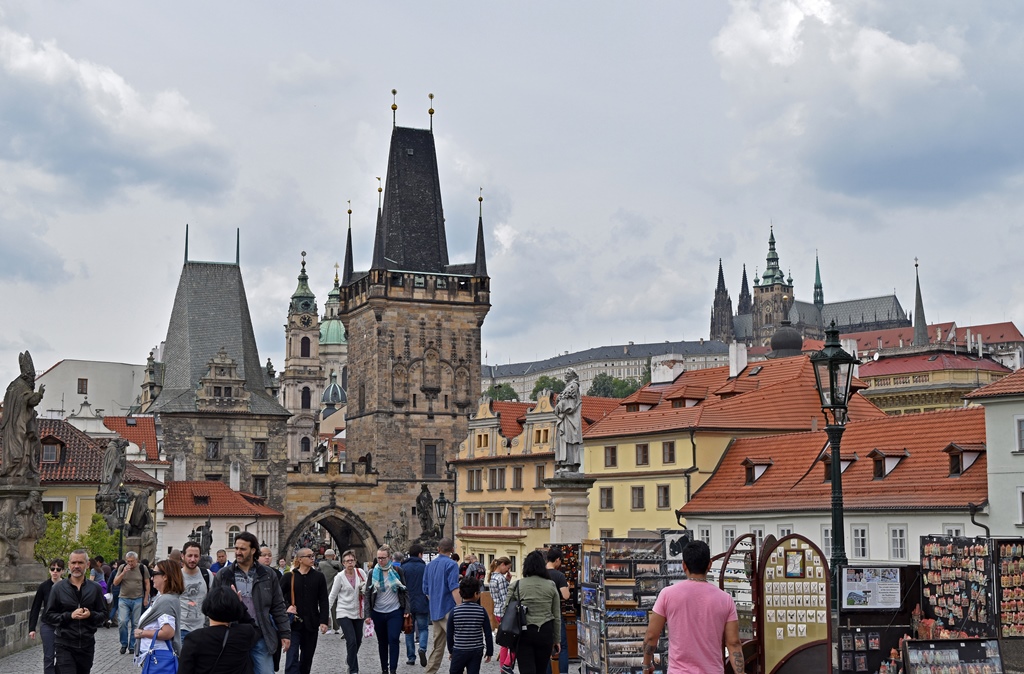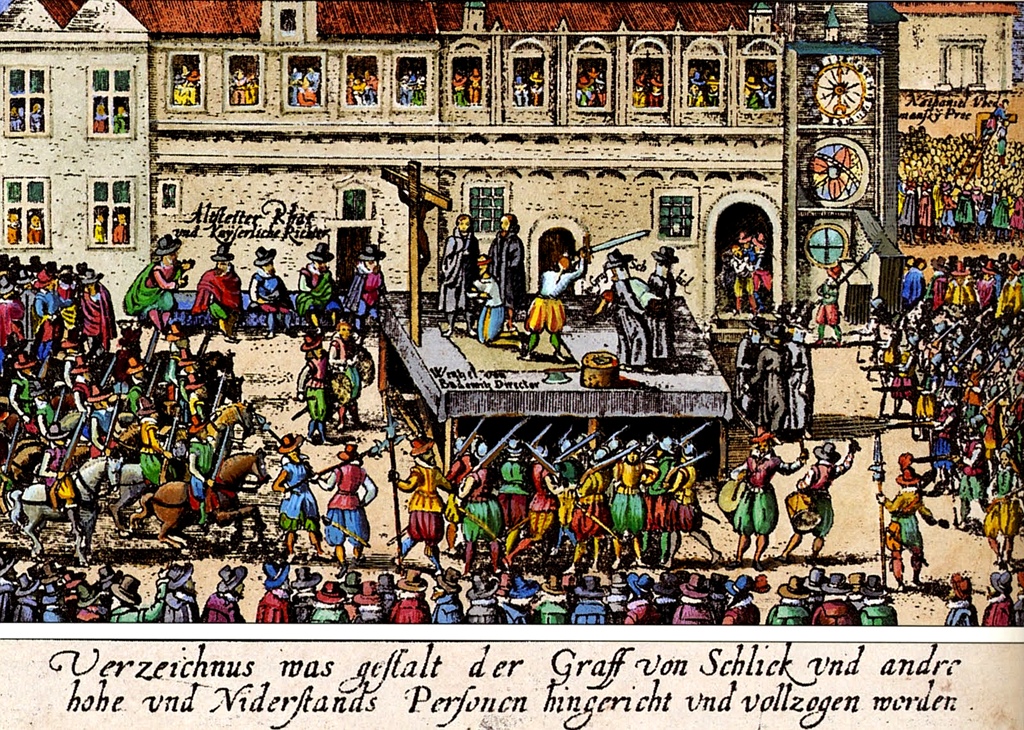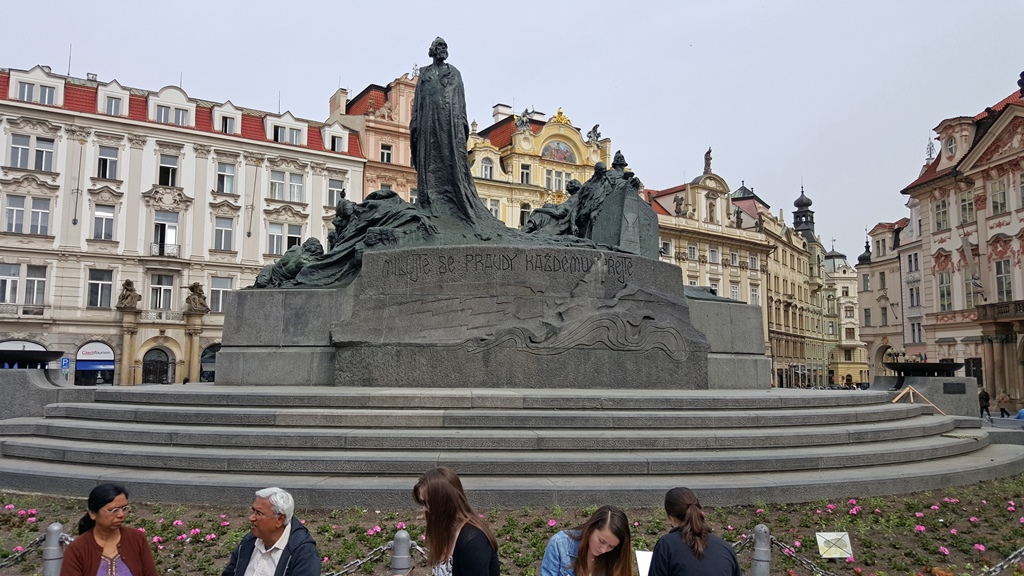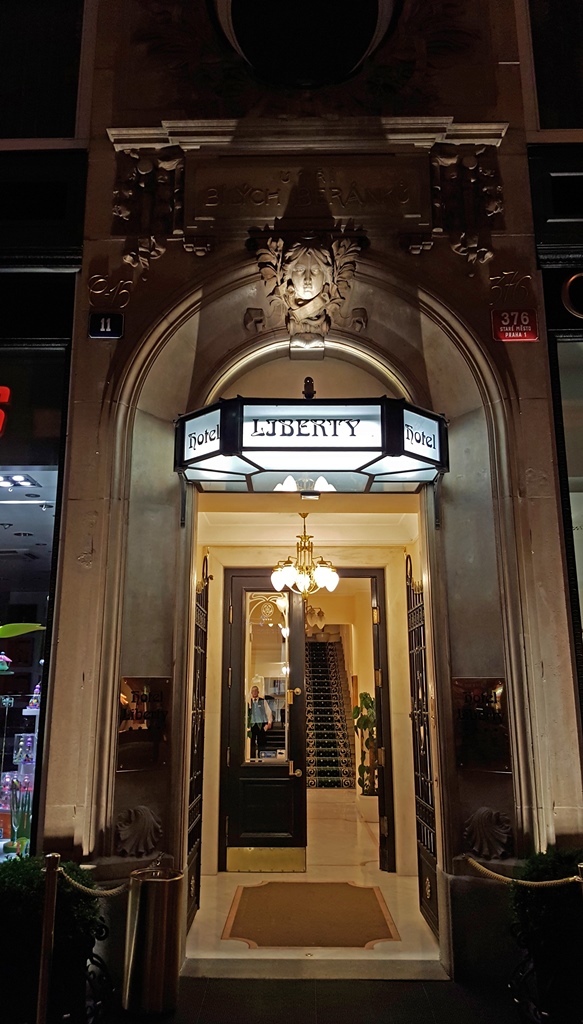Charles Bridge and Little Quarter
Prague is the largest city (1.3 million people) in the Czech Republic, and also its capital.
Prague escaped much of the devastation that was inflicted on many European cities during
World War II and retains much of its historical architecture. It’s sometimes called the
“city of spires”, and it does seem to have more than its share. The city is cut in two by
the scenic Vltava River, which flows northward through the city on its way to join the Elbe
(which eventually empties into the North Sea), and there is plenty to see and do on both
banks.
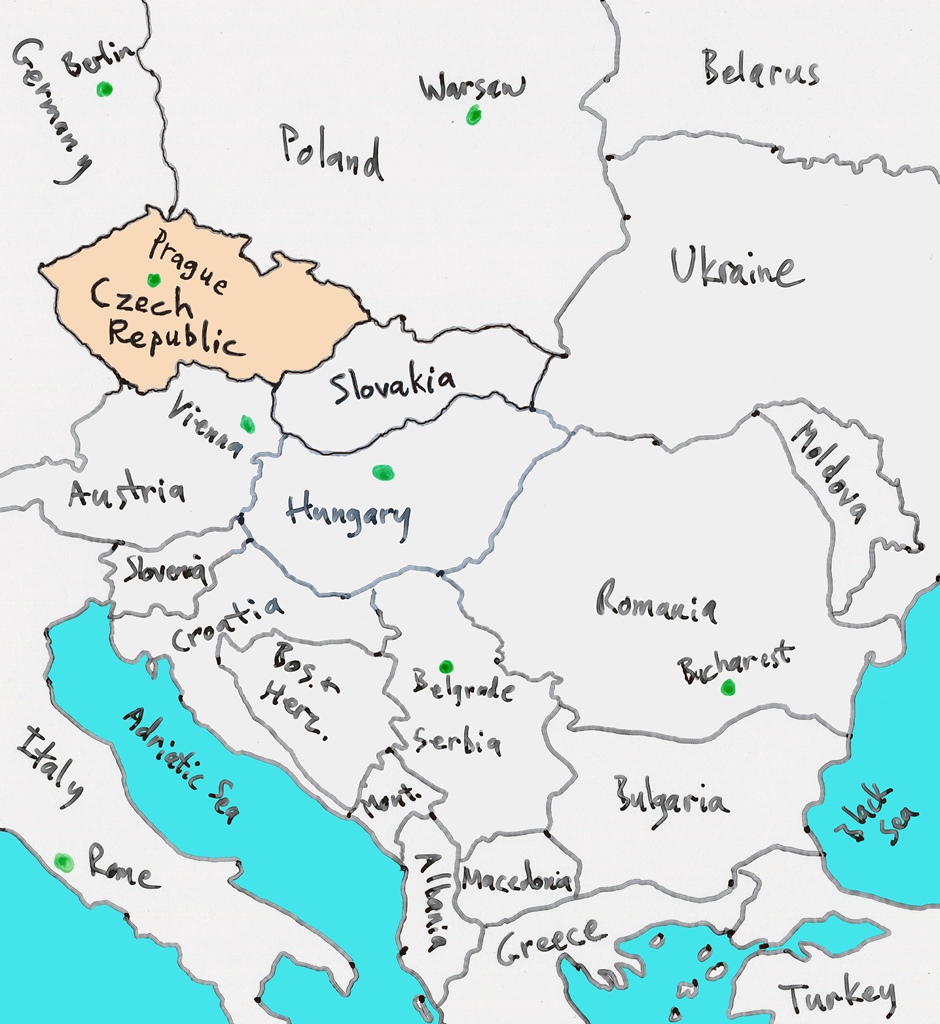
Central Europe
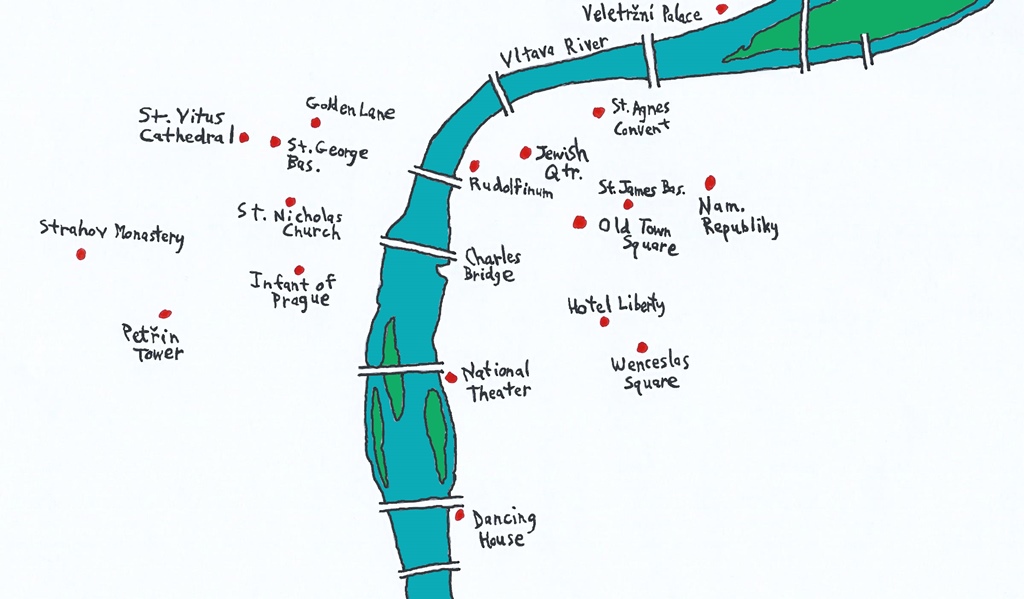
Prague
Prague began as a fortified settlement on the west bank of the river in the 9th Century A.D. The
area was then known as Bohemia, a name which had come from the Boii, a Celtic tribe
which had been the first known tribal inhabitants of the area around 500 B.C. The Boii had been
followed by a Germanic tribe called the Marcomanni in 9 A.D. (the Celts migrated southward),
and then around 512 A.D. by a Slavic tribe known as the Czechs (some of the Marcomanni
joined with another Germanic tribe called the Lombards and migrated south, while others stayed and
assimilated with the Czechs). Bohemia was eventually ruled by a succession of dukes and princes of
a dynasty called the Přemyslids, and after founding Prague, they used it as their center of
operations. One of the 10th Century dukes was Wenceslas I, the “Good King Wenceslas” of the
Christmas carol and now patron saint of the city. Good or not, his reign didn’t end well for him,
as a group of nobles including his younger brother assassinated him in 935. But this did qualify
him for martyrdom and sainthood.
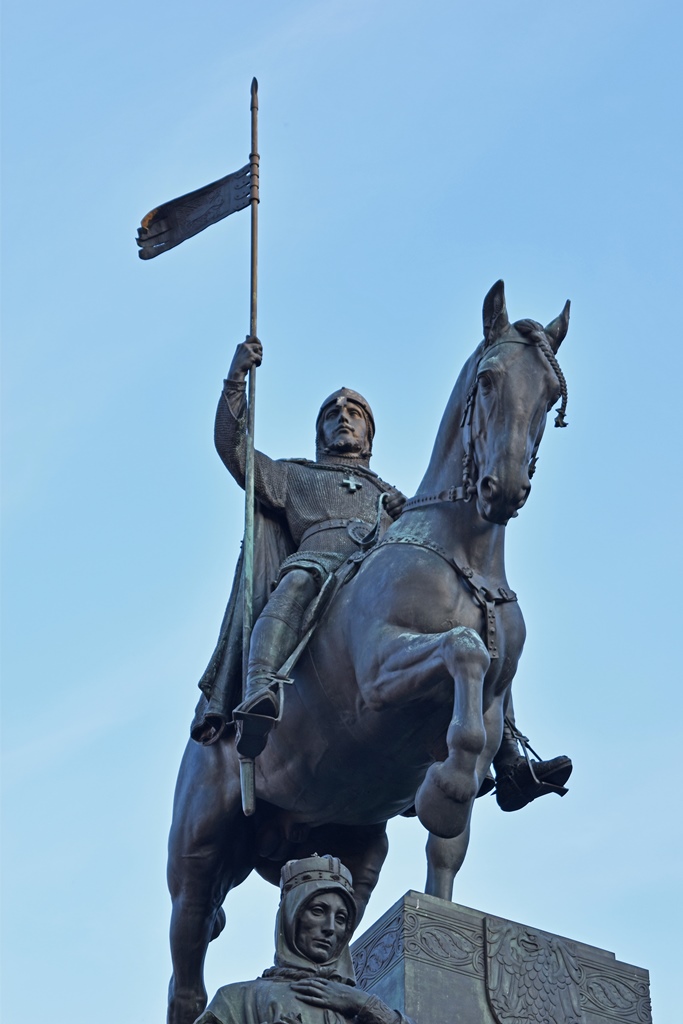
Wenceslas I
Early in the 11th Century, the Bohemian dukes became vassals of the Holy Roman Empire, which in
1085 bestowed upon Bohemia the status of being a kingdom, with its first king being Vratislaus I
(who had been Prince Vratislaus II of the Přemyslid line). The throne at first was not a
hereditary one, but became one about a century later. The throne of the Holy Roman Empire also
wasn’t hereditary, and Bohemian King Ottokar II attempted to gain the imperial throne in 1278.
But he lost the Battle on the Marchfeld (and his life in the process) to Rudolf I, the first
German king in the Habsburg dynasty (Rudolf was not able to gain the imperial crown due to
French political maneuvering).
The Přemyslid dynasty ended in 1306 with the death without heir of Wenceslaus III at the age of
16 (like Wenceslaus I, he was murdered). But Wenceslaus had a sister named Elizabeth, who
married John, son of Holy Roman Emperor Henry VII in 1310. John was only 14 at the time, but
his followers were able to secure the Bohemian throne for him by deposing the reigning king.
John was the first Bohemian king from the House of Luxembourg, but he was not the last, as he
and Elizabeth were able to produce an heir named Charles in 1316. John had ambitions of
following his father to the imperial throne, but the prince-electors who selected the emperor
voted for a Bavarian duke instead. The Bavarian didn’t live forever, dying in 1347, but John
had unfortunately died first, in 1346 at the Battle of Crécy in France. Charles, however, was
30 years old by this time and succeeded his father as King of Bohemia. He spent the next few
years expanding his kingdom and consolidating his power, and in 1355 he was crowned Holy Roman
Emperor Charles IV, basically without opposition. Charles was the first Bohemian emperor, and
chose to use Prague as his base of operations. To make the city more suitable as the center
of an empire, he spent a lot of money largely rebuilding it, using 14th Century Paris as a
model. A lot of his handiwork still exists, and you’ll be seeing some of it in pages to come.
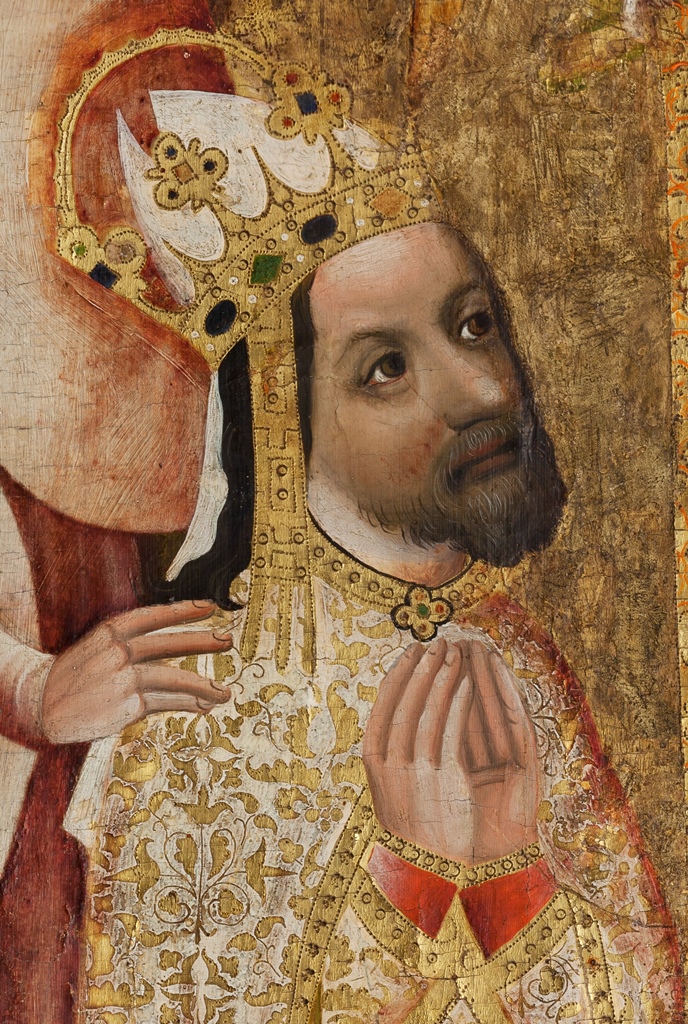
Charles IV
Around this time, a period of religious conflict in Europe had its beginnings, and Prague
and Bohemia were at its forefront. In Prague, a priest named Jan Hus, influenced by the
writings of an Englishman named John Wycliffe and anti-papal views taught to him by some
of his professors at the University of Prague, took to preaching ferociously about corruption
in the Catholic Church. One of his primary targets was the church’s sale of “indulgences”,
by which someone could give a church representative money to shorten a deceased ancestor’s
time in purgatory (and presumably to release him or her to heaven). If this sounds familiar,
it might be because this is one of the main issues that would be hit by Martin Luther a
hundred years later. Hus struck a nerve with the Bohemian populace, eventually speaking to
large, enthusiastic crowds and catching the notice of the higher-ups in the church. He
received warnings to cut it out, but ignored them. In 1414, Sigismund of Hungary, the head
of the Holy Roman Empire (but not crowned emperor yet) convened a council in the city of
Konstanz in southern Germany, where the church and Hus would be able to air their differences.
Sigismund gave Hus a promise of safe conduct, but this turned out to be wishful thinking. Hus
was arrested and tried for heresy after some preliminary discussions, and Sigismund was told
that promises to heretics didn’t count. In June of 1415 Hus was burned at the stake after
refusing to renounce his statements.
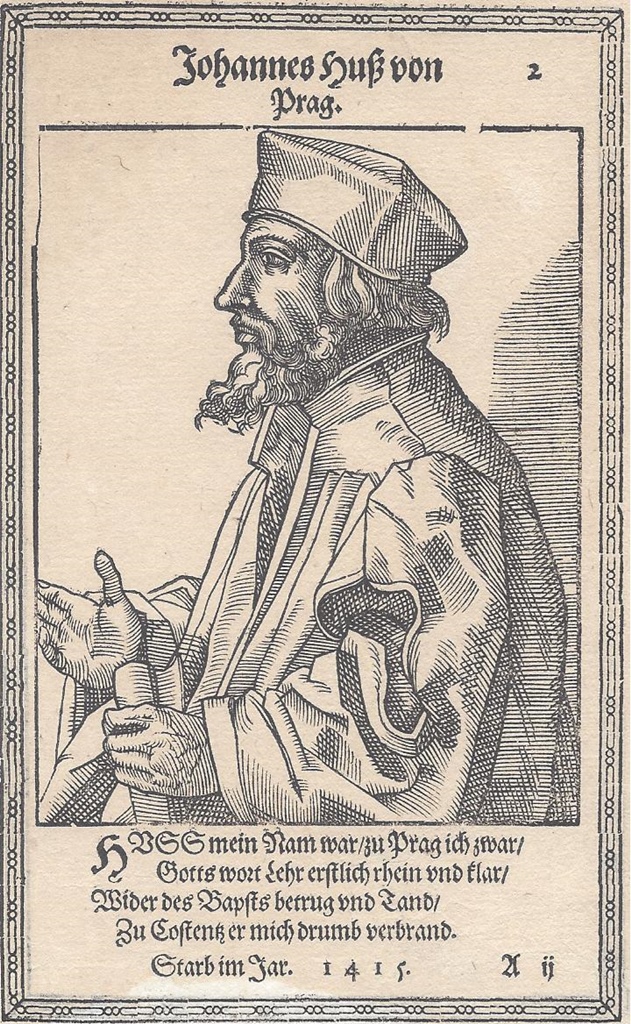
Jan Hus
Back in Bohemia, people were outraged and moved strongly away from Papal teachings. Rome didn’t
stand for this and organized a crusade against them. But the Bohemians were ready for this and
were able to defeat the crusade. Three more crusades followed (collectively referred to as the
Hussite Wars), and the Bohemians repulsed them each time. At this point, negotiations were
initiated and a compromise was reached which allowed Bohemia to practice its own version of
Christianity, a version that proved to be very popular during an uneasy truce until tensions
reached a boiling point again in 1618. At this time, hard-line Holy Roman Emperor Ferdinand II
was trying to impose religious uniformity (standard Roman Catholicism) on everyone in the
empire. In a meeting at the Bohemian Chancellory in Prague, some of the emperor’s
representatives, who had presented a threatening letter declaring Protestant lives to be
forfeit, were bodily thrown out of the Chancellory window in an event known as the
Defenestration of Prague. The representatives survived the 70-foot fall as it turned
out – Catholics maintain they were saved by angels, and Protestants say they were cushioned by
a dung heap.
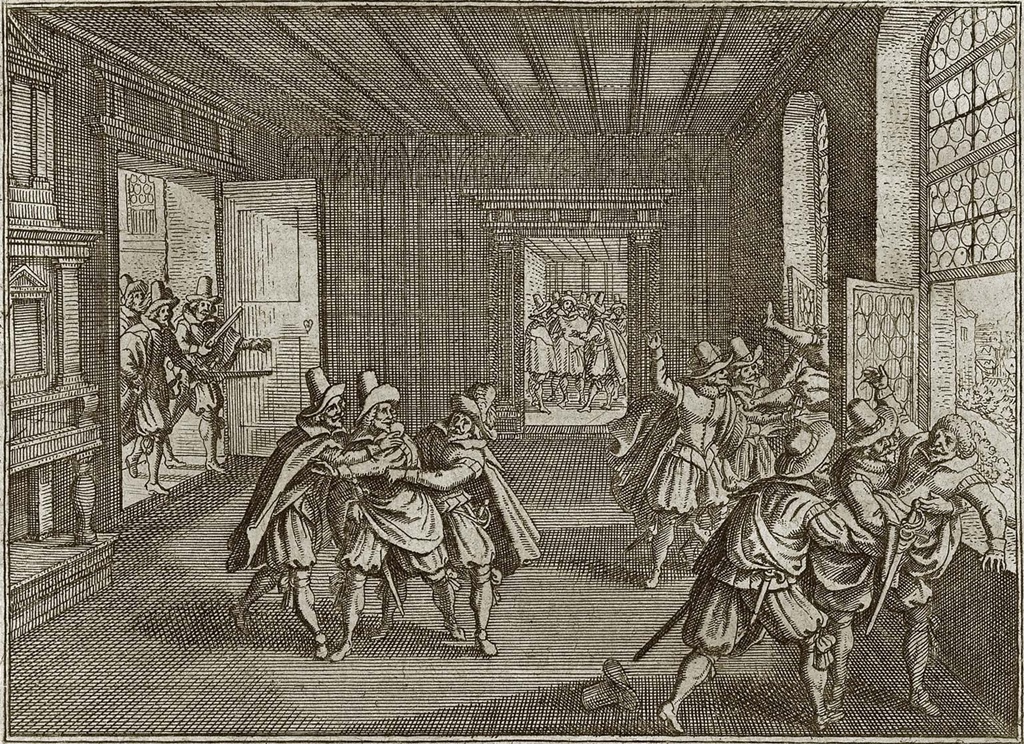
The Defenestration of Prague
Regardless, the emperor wasn’t even slightly amused, and he sent an army to teach the Bohemians
a lesson. First, the Bohemian army was crushed in the Battle of White Mountain in 1620, and
then mass executions of Bohemian aristocrats were undertaken.
Prague Executions, 1621
Protestant states from across Europe were outraged by the Catholic atrocities and sent their own
armies, and the Thirty Years’ War was underway. Between the violence, famine and plague, this
war resulted in the death of eight million people. The war also pretty much spelled the end of
Protestantism in Bohemia. Even today, the religious community in Prague is overwhelmingly
Catholic. But even so, Jan Hus is still considered a national hero, and there is an impressive
monument to him in Prague’s Old Town Square.
Jan Hus Monument, Old Town Square (1915)
In addition to losing its religion, Bohemia lost most of its autonomy following the Battle of
White Mountain, with Habsburg emperors keeping them on a short leash for many years. During these
years, German became the semi-official language in the cities (including Prague), with Czech
mainly being spoken in rural areas. When the Holy Roman Empire was dissolved in 1806 after being
defeated by Napoleon in the Battle of Austerlitz, Bohemia ended up in the new Austro-Hungarian
Empire, as part of Austria. Like Hungary, Bohemia pushed for more autonomy in the new empire, but
unlike Hungary, Bohemia never achieved this goal. This had to wait until the end of World War I
in 1918, when Austria-Hungary ceased to exist. At this time, Austria and Hungary continued to
exist as independent countries, but lost a great deal of territory to existing countries and to
newly-formed ones, including the First Czechoslovak Republic, which was mostly created from the
Austrian regions of Bohemia and Moravia-Silesia and the Hungarian region of Slovakia.
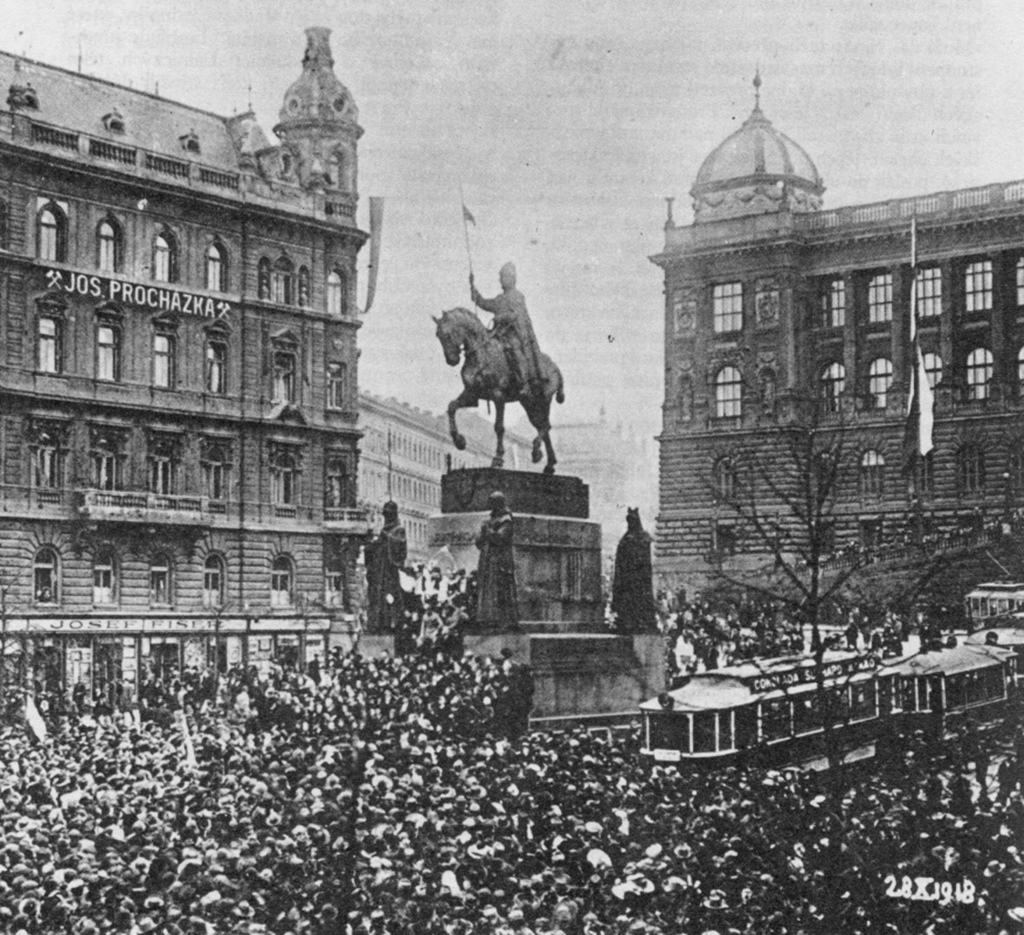
Prague Celebrating Independence from Austria-Hungary
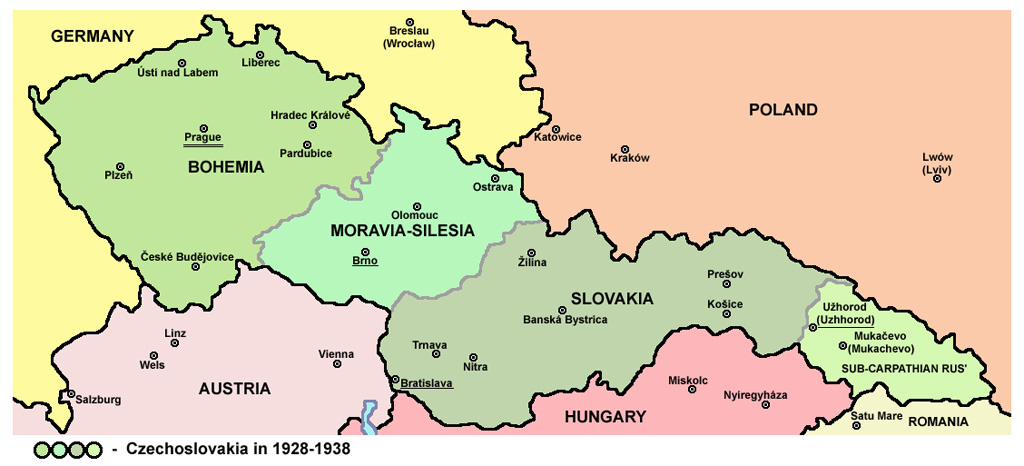
Czechoslovakia Before World War II
Though both the Czechs and the Slovaks were undoubtedly happy to be liberated from Austria-Hungary,
there was a certain amount of friction between them. Clearly there were ethnic and linguistic
differences, but mostly the Slovaks must have felt underrepresented, as they were outnumbered by
the Czechs two-to-one. But by 1938, both groups had much more to worry about, as they had caught
the covetous eye of Adolf Hitler. Over in Bohemia, the Czech language had largely returned to the
cities, and the German-speakers were mostly in the border areas of the new Czechoslovakia. Hitler
was threatening to start a war in Europe, but promised to behave himself if the German-speaking
areas of Czechoslovakia, referred to as the Sudetenland, were turned over to Nazi Germany.
Negotiations were begun between Germany, France, Britain and Italy (and nobody from Czechoslovakia),
and Hitler’s terms were agreed to (in something called the Munich Agreement), as Britain and France
still remembered the horrors of World War I, and wanted to avoid a repeat at all cost. The Czechs
and Slovaks understandably considered this to be a betrayal, but there wasn’t much they could do
against the diplomatic and military pressure arrayed against them. Of course this attempted act of
appeasement failed, and Hitler swallowed up the rest of the country within a few months. By
September of 1939, Hitler had invaded Poland, and World War II was underway.
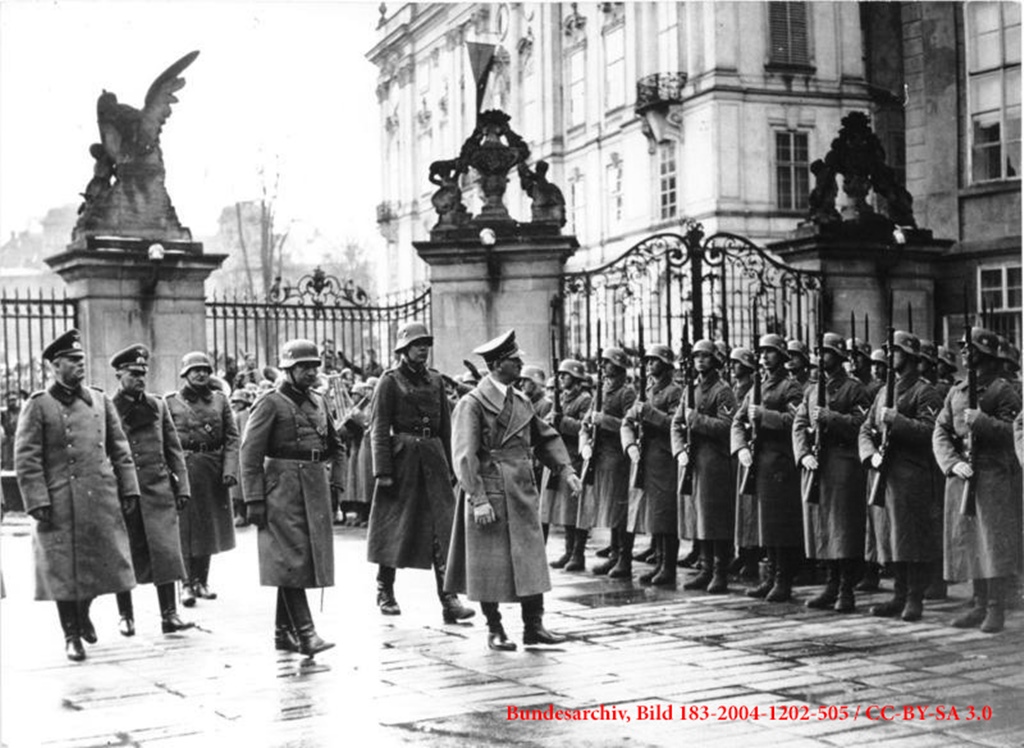
Hitler Visiting Prague Castle, 1939
The Nazis, of course, were the worst occupiers imaginable. They sent virtually all the Jews
(and a good number of other Czechs) to concentration camps, stole everything that wasn’t nailed
down and responded to any attempts at resistance with horrible atrocities. Czechoslovakia was
eventually liberated from the Germans by George Patton from the west and the Red Army from the
east. The country was reconstituted (there had been a “government-in-exile”, which helped) and
was again a republic. Not being pleased with the treatment they’d received during the war,
they expelled nearly all the German-speakers (who had mostly been Nazi sympathizers) from the
country and formed a government which was generally favorable to the Soviet Union (no doubt
remembering their betrayal at the hands of France and Britain). The largest of the political
parties was the Communist Party, which at an opportune moment in 1948 staged a coup d'état and
installed a single-party, authoritarian, pro-Soviet government. With the help of the Soviets,
they trained their secret police, the Státní bezpečnost (“State Security”), or StB, in
methods of spying and extracting information and confessions from prisoners, and in keeping
Czechoslovak citizens from defecting to the west. It didn’t take long for the Czechoslovak
citizenry to figure out that the west maybe wasn’t so bad after all, but by then they were
pretty much stuck. In 1968, a man named Alexander Dubček became the party’s First Secretary,
and he started to implement some reforms, including decentralization of the economy and
democratization, while loosening restrictions on speech, media and travel. The Soviets, under
Leonid Brezhnev, were appalled by these developments and tried to talk the Czechoslovak
leadership into reversing them. When this didn’t work, they organized an invasion of the
country, along with forces from Warsaw Pact countries Bulgaria, Poland and Hungary, and
occupied Czechoslovakia with 200,000 troops and 2,000 tanks.
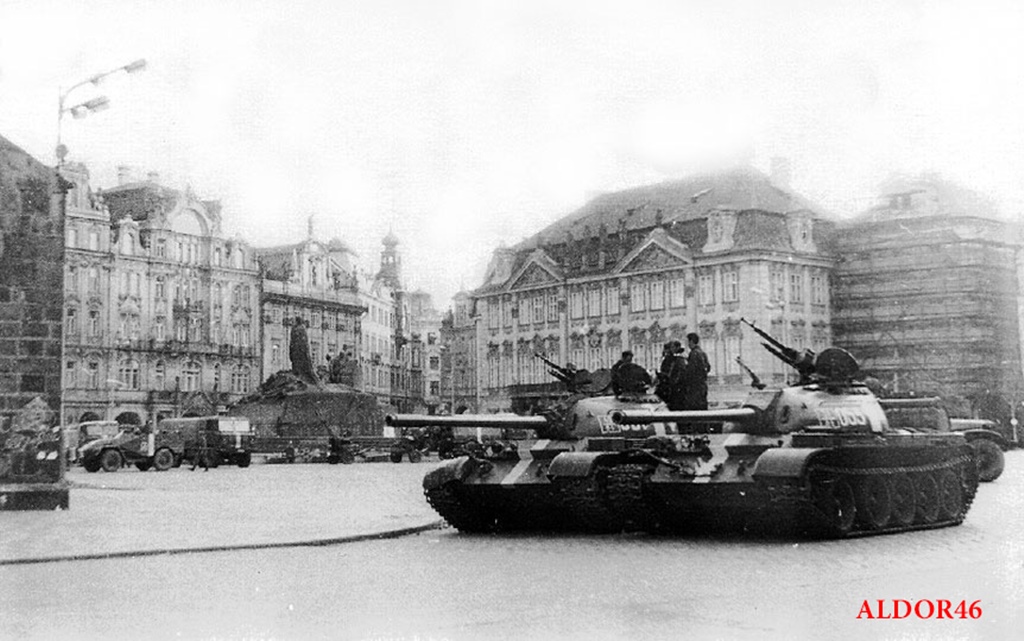
Soviet Tanks in Old Town Square, 1968
Dubček encouraged the citizenry to not resist, and most people didn’t, as the odds against them
were obvious. Dubček was allowed to remain in his post and to temporarily keep some of the reforms
in place, in order to defuse possible protests, but in 1969 he was removed and replaced with a
hard-liner who reversed all of the reforms.
Things stayed this way for several years, but in 1989, Glasnost (openness) and
Perestroika (restructuring) were in the air, courtesy of Soviet General Secretary Mikhail
Gorbachev, and the Warsaw Pact was crumbling. Authoritarian governments were being removed right
and left, not always peacefully. Prague citizens decided it was time to try their luck again, and
in a series of gigantic demonstrations now referred to as the Velvet Revolution, the Communist
government was persuaded to step aside and allow a non-Communist government to be installed.
Playwright and human rights activist Václav Havel was elected President and successfully negotiated
the removal of Soviet troops from the country by early 1990. By popular agreement, the economy was
transformed into a market economy, but again it didn’t take long for disagreements to surface
between the Czechs and the Slovaks. In 1992, discussions began on a breakup of the country into
two, and agreement on the details was eventually reached. The split took effect on January 1, 1993,
when the Czech Republic and Slovakia were created. This event is referred to as the Velvet Divorce.
Reactions at the time were mixed, among both Czechs and Slovaks, who would've liked a chance to vote
on it. Havel was opposed to the breakup, and resigned so he wouldn’t have to preside over it.
Opinions remain mixed to the present day, but at this point it’s pretty much just a fact of life.
We were looking forward to visiting this history-laden place, but to get there we first had to leave
London, another history-laden place. Our flight to Prague was to leave from Stansted Airport, which
we’d never heard of before making the reservation. Stansted turned out to be 42 miles northeast of
central London, reachable by taxi for the wealthy or for the rest of us via a train called the
Stansted Express that leaves every fifteen minutes from the Liverpool Street station. Stansted
Airfield was used during World War II for the launching of bombing raids, and immediately after the
war was used for housing German prisoners of war. Today, after many improvements, it is mostly used
by lower-cost airlines, such as easyJet, which flew us across the English Channel and much of
continental Europe to Prague’s Václav Havel Airport.
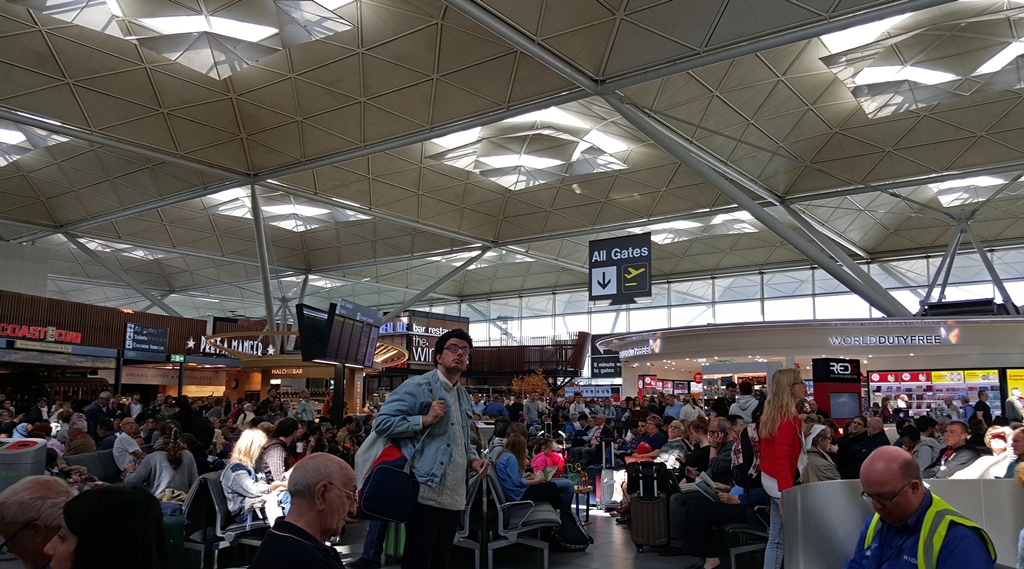
Stansted Airport

Stansted Airport and Surrounding Countryside
On arriving at Prague Airport, we immediately looked for an ATM. While Slovakia elected to go with
the Euro beginning in 2009, the Czech Republic decided to stay with their own currency, the Czech
koruna. The symbol for Czech korunas is Kč, and at the time of our trip, a koruna was worth
about 4.3¢ in U.S. money. Euros are pretty easy to find in the U.S. (though the exchange rates are
usually horrible), but korunas are more of a challenge, so we decided we would just visit an ATM as
soon as we got into the country. Fortunately for us the ATM was easy to find, as we needed the
cash right away. Not much of it, though, as we’d decided to try getting into town using the
ultra-cheap method: the Metro. Using the Metro in Prague is very inexpensive, but there’s one
problem – it doesn’t go all the way to the airport. You need to take a bus from the airport to get
to the Metro, and then the Metro takes you the rest of the way into town. Simple in concept, but
less simple when you’re loaded down with luggage and the bus isn’t designed for passengers with a
lot of luggage. Usually an airport bus will have a section where everyone can leave their luggage,
but this bus did not for some reason. So there was luggage in the aisle, on people’s laps and
shoehorned in where people would normally try to put their feet, and the bus ride was less than
comfortable. And then we had to drag all of our luggage down into the Metro tunnel and onto the
train, but this part was about what we’d expected. We’d done some research beforehand, and we got
off at a stop we knew to be just down the street from our hotel. Total fare: 32 Kč apiece, or
$1.34 in U.S. money. Our research also included a look at Google Maps Street View, which we’d used
to figure out exactly how to get from the station to the hotel, which wasn’t as straightforward as
one might expect. The station was in a complicated intersection where the streets weren’t marked
very well, and the entrance to our hotel, the Hotel Liberty, consisted of a door sandwiched between
two stores. But knowing what to expect, we found the hotel, checked in and took a much-needed rest.
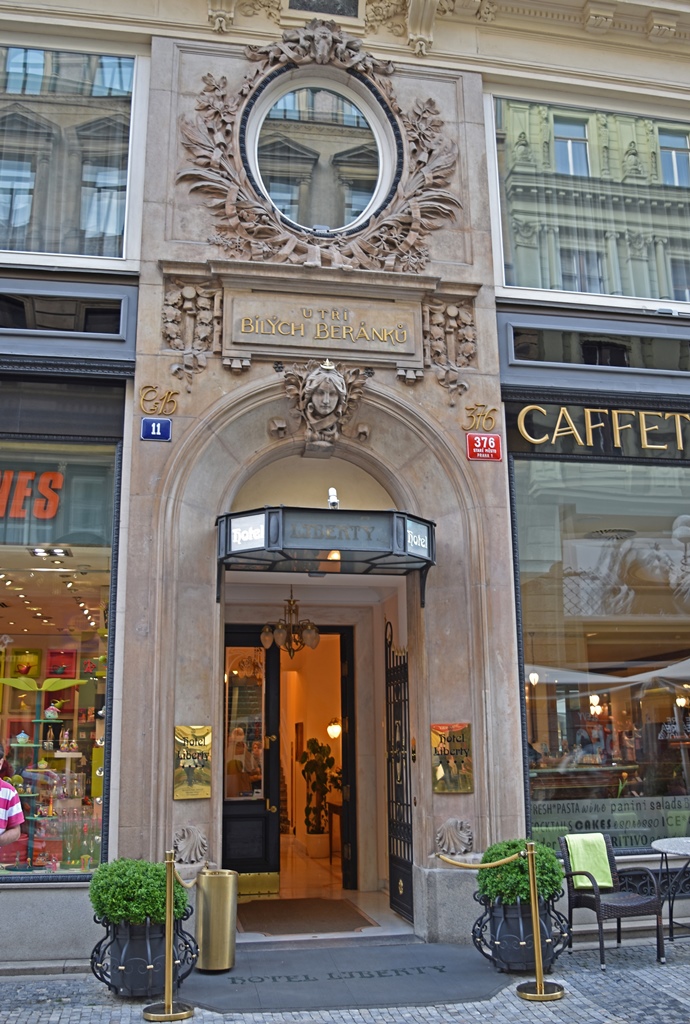
Hotel Liberty
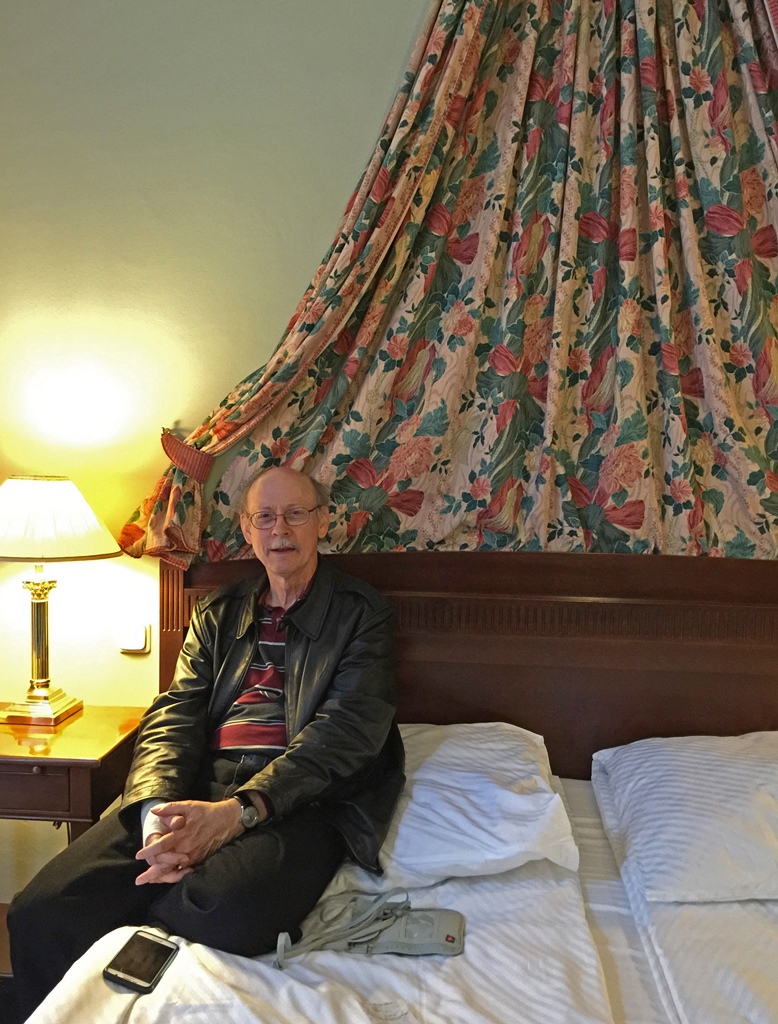
Bob in Hotel Room
One of the difficulties of visiting Prague (Praha in Czech, pronounced about how it looks)
is dealing to some extent with the language. Not really to speak it or understand someone else
speaking it, though – the Czechs know their language is a challenge for foreigners, and nearly
everyone in the tourist-visited areas knows some English. But not totally everyone, and there is
some signage you might have to figure out. Czech is a Slavic language, like Russian, Polish,
Slovak, Bulgarian and others, so if your experience with foreign languages is limited to Romance
or Germanic languages, you’ll probably feel pretty lost at first. The basic vocabulary, the
grammar and even the alphabet don’t quite match up. But things could be worse: there are a lot
of international words (like newish products or technological terminology) which are similar
everywhere, and Czech, considered a Western Slavic language (like Slovak and Polish), at least
uses an alphabet which uses the western Roman alphabet as a starting point. In other words, the
Czech alphabet, unlike the Russian alphabet, is not based on Cyrillic. It does have some funny
marks on a lot of the letters, though. These came from the same need that were satisfied by the
Cyrillic alphabets – the need to represent in writing the sounds commonly coming out of
conversing Slavs, for which the standard Latin alphabet is not well suited. For example, the
“zh” sound, like the “s” in “measure”, can be represented as “zh”. But the Cyrillic alphabet
was created in the 9th Century for Slavs who didn’t have a written language, and creating
different sounds with somewhat arbitrary combinations of letters would have created a level of
complexity that might have discouraged the alphabet’s use. So, for instance, in Russian, the
“zh” sound is represented as the single letter Ж, while in Czech, it’s represented as Ž (the
thing over the Z is called a háček). Here are some letters and pronunciations you
might not expect:
- ě – ye as in “yeti”
- c – ts as in “its”, č – ch as in “cheesy”
- s – s as in “salad”, š – sh as in “shingle”
- r – r as in “reindeer”, ř – rzh as in “Dvořák”
- z – z as in “Zorro”, ž – zh as in “measure”
- u – u as in “put”, ů – oo as in “poodle”
- j – j as in “Jägermeister”
- n – n as in “Nefertiti”, ň – ny as in “canyon”
Most of the pronunciations are pretty consistent, and with a little practice they become less
difficult. Grammar-wise, though, things get ugly pretty quickly. You might be familiar with
languages that have genders for all their nouns (“la mesa” vs. “el burrito”),
but the Slavic languages add a third gender, so there are masculine, feminine and neuter nouns
(German also does this). Also, some languages have the concept of case, in which
different endings are applied to nouns and their adjectives, depending on how the noun is used
(subject, direct object, indirect object, etc.). Endings depend on both the case and the
gender, and you just have to know them. To go with its three genders, German has four
different cases. Czech has seven. Don’t get into the grammar if you don’t have to.
After resting for a while, we went out in search of food. Our hotel was located at the bottom
of Wenceslaus Square. Wenceslaus Square isn’t so much a square as a long, wide street which
is partly pedestrianized. It’s lined on both sides by some interesting old buildings in the
art nouveau and art deco styles, and there is plenty of night life, with
restaurants, shops and drinking establishments. The street climbs gradually to a large domed
building at the top which is currently home to the National Museum. Wenceslaus Square is also
a gathering point for celebrations and demonstrations, and played a big role in the Velvet
Revolution in 1989.
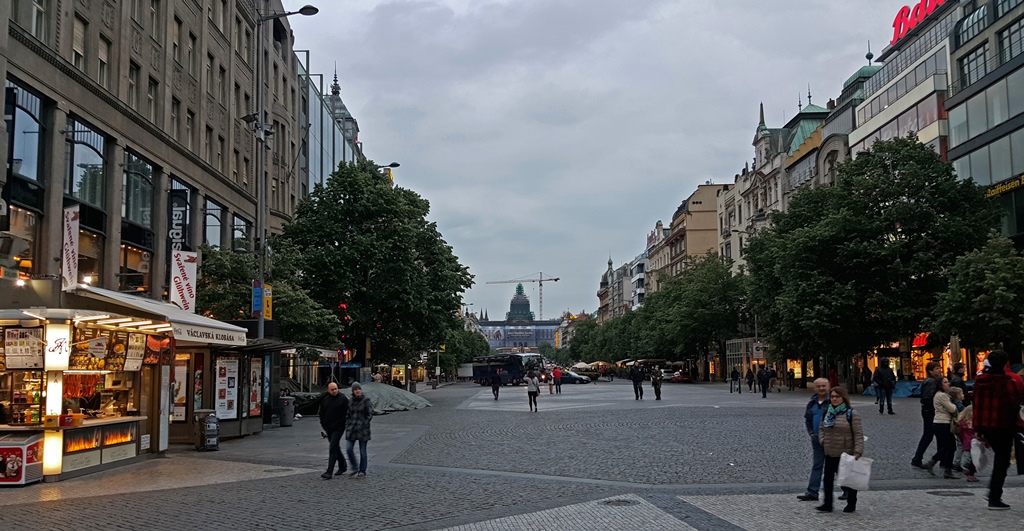
Wenceslas Square
We stood at the bottom of the square and noticed some stands that were selling street food that
looked and smelled delicious.
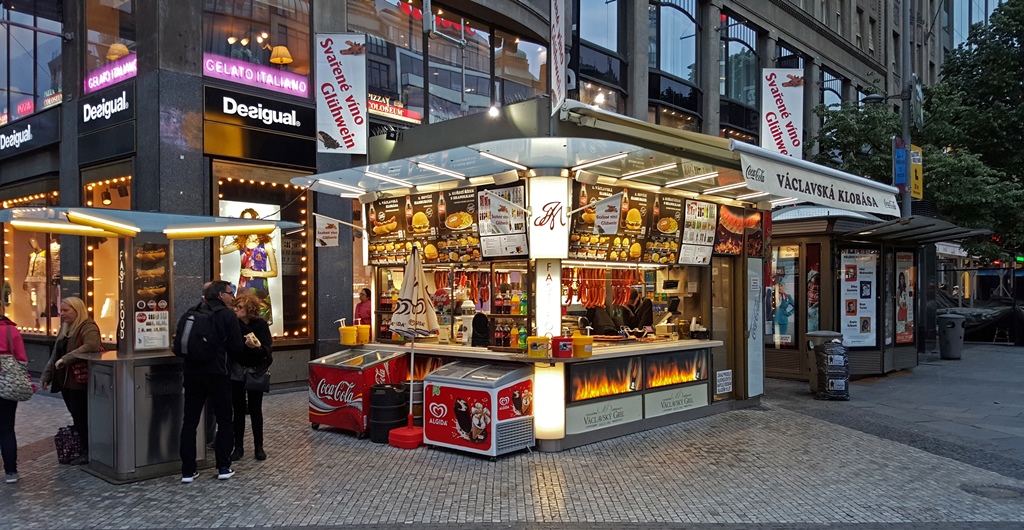
Sausage Stand, Wenceslas Square
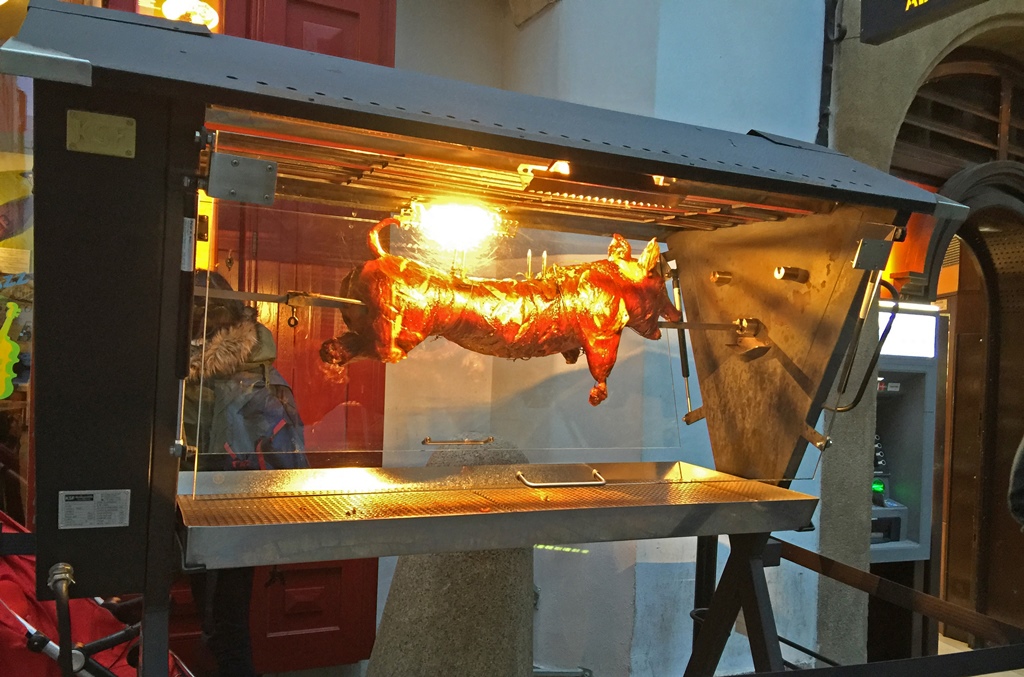
Roasted Pig, Wenceslas Square
We were looking for something more substantial, though, and we ended up in an Italian restaurant,
if I remember correctly. We headed back to the hotel, which looked nicer with the lights on.
Hotel Liberty
We were pretty tired after the day’s exertions and went right to sleep. But tired or not,
our plans for the next day were ambitious. We were going to start with a visit to the
Infant of Prague.

